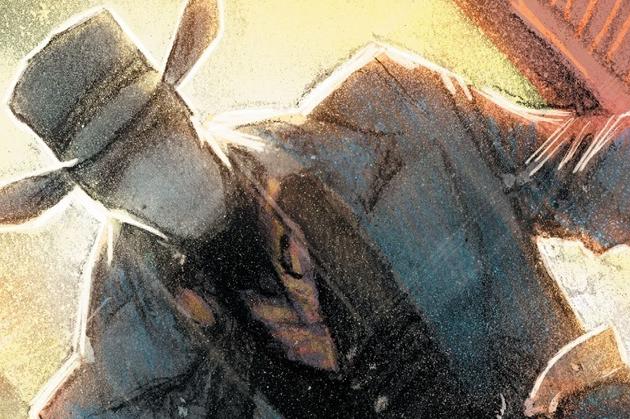The Question: The Deaths of Vic Sage #2 Review
Written by: Jeff Lemire
Pencils by: Denys Cowan
Inked by: Bill Sienkiewicz
Colors by: Chris Sotomayor
Lettered by: Willie Schubert
Published by: DC Black Label
Vic Sage is down the rabbit hole. After a trail of clues leads the Question to start questioning his past, he will now have to face his many deaths if he wants to come out alive.
From the offset, we’re in unfamiliar yet familiar territory. Same place, new time: Hub City 1886. The new character of focus is Viktor Szasz. He is another familiar yet different aspect. He, like Vic Sage, is a man torn between his two sides. While Sage is torn between the two masks he wears, Szasz is torn by the good and evil he sees within himself. We’re then taken on a journey of him discovering how to resolve this inner struggle. The setting and tone change as well. The distinctly noir feeling is now melded with identifiably Western elements. Besides using the mise en scène of a Western, the story harkens back to the mysterious gunman character of classic films like Shane and Unforgiven; the noir element still shines through, though.
Viktor eventually witnesses the wrongdoing of an honest man. This event gives him the drive to fight past his inner struggle and do what he feels is right. The story of Irving Booker was a well-handled narrative. Like in the previous issue, Jeff Lemire doesn’t just do a deep dive into a character’s mentality or just weave an engrossing and well-written narrative, he is able to do both flawlessly. It's a balancing act hard to do at any level let alone with such quality of writing. The “Booker story” is just as interesting as the story of Viktor's development. And, the stories join at the emotional peak. It seems like I should have been ready for all possibilities in the story, but the writing was done so well that every turn resonated with me fully.
When Viktor reaches the point where he completely understands what he is capable of doing (he is helped along that path by another character) it’s when he has reached the growth he's yearned for from the opening pages. He resolves his nature and goes forth to use it in the way he sees best. He has his big “hero moment” and after he has done his job, or before he could hit his stride, we are transported to another place. With the end allowing both the awakening character and the reader to sit with what has happened, it becomes clear what this digression was. In a noir story, a detective will go to the deepest, darkest hole to find his answers. The detective will go underground to the abyss, risking his own soul. In this story, instead of journeying into a seedy district, Sage enters his legacy to reach into the void and grab out the necessary clues. And, by the end of the comic, the Question has gotten one step closer to getting his answer.
In a seemingly impossible turn of events, the art is even stronger in this issue. Great art can transport the reader to a different time with the perfect visuals and scenery, and this issue has that in abundance. It’s not just the Western aesthetic that makes the art such a treat in this issue, it's the detail of the shots. Denys Cowan & Bill Sienkiewicz are the dynamic duo of comic art. Cowan, being the penciler, gets the credit for the great shot compositions, excellent panel layouts and overall choice of what to focus on. One particular aspect that stands out in this issue, and I can’t overstate how brilliantly they stand out, are the faces of characters. Slightly ironic for a comic where the titular character is known for being faceless. The detail on the close-ups of Booker and his wife, Viktor, the Preacher, and many others steal the pages they are on. They're reminiscent of close-ups by, Western legend, Sergio Leone. One panel I can point out is of a man being shot by an arrow. This, and many others, have an impressionistic feeling to them, as does the art of the book in general. That's where those methodically mad lines of Bill Sienkiewicz come into play. The way the seemingly chaotic lines flow and give way to express or give detail is beautiful. It was a genius thought to add the pencils and inks to the backmatter of the comic. It shows what Cowan lays down and what Sienkiewicz lays on top. It gives a new level of respect for art I already loved. The coloring may be some of the best I’ve seen in a comic ever. Chris Sotomayor's intricacy is on display in many titles, but here it is just awe-inspiring. He’s one of those colorists who, capital K, Knows the material he’s working on and affects the mood of each scene as much as any other person that has a hand in making this book.
This is the series to read. If the writing can accomplish what it has done steadily for two issues and the art can stay at the level it's at, this is going to be one of the great ones. Two straight issues have been able to explore two different characters’ duality while weaving an inventive story around them. I haven’t read many comics that have done this and don’t know of any others doing it now. If you’re a fan of cerebral comics, this is the one to pick up.





